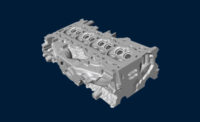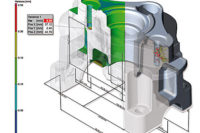The future of industrial 3-D X-ray inspection is considered to be in the hands of North Star Imaging, Inc.’s newest development Industrial X-ray technology, the Four Dimensional X-ray Computed Tomography (4D CT). 4D CT is described as being a 3-D X-ray Computed Tomography process that captures movement over a length of time. According to North Star, the process results in a “truly dynamic 3-D volumetric data set.”
Industrial Computed Tomography is a diagnostic imaging tool in the medical field that allows for 3-D inspection of a varied range of objects. While Computed Tomography has been around for about thirty years, it has not been considered a highly practical inspection technique until about 5 years ago.
“It is on its way to becoming the industry standard for many NDT applications,” said Chris Damhof, Marketing Coordinator for NSI. 3-D Computed Tomography is defined as the process of capturing hundreds or thousands of individual 2-D X-ray images around a 360 degree rotation of an object. According to Damhof, “this process is highly taxing on computer hardware and historically took hours and even days to complete. In recent years, fast improving computer hardware, combined with innovations such as North Star Imaging’s GPU (graphics processing unit) reconstruction process has significantly reduced the amount of time it takes to reconstruct a 3-D CT model.” Moreover, in the past, motion has always been sharp image quality’s enemy because any movement would result in blurred images. As a result, North Star Imaging, Inc. (NSI) asked itself how it could overcome this limitation and have better capabilities to study objects that have moving internal parts. According to Damhof, in seeking an answer, NSI developed the 4D Computed Tomography.
The development of 4D CT was a culmination of many innovations at NSI over the past 5 years. Damhof said that “the ability to acquire clear 2-D images while in motion, the capability to reconstruct a 3-D CT model in a matter of seconds and even optimizing hard drives to write and store data quickly enough were just some of the challenges that needed to be overcome.” Speed and efficiency is crucial with the 4D CT. In fact, 4D CT is completed by obtaining continuous 3-D Computed Tomography reconstructions and shaping them into one 4D CT model. “The motion captured in the 4D model can then be played like a movie while the user simultaneously slices through and inspects the internal functionality of the object at any angle. The motion can be viewed in forward or reverse, it can be paused and restarted and even navigated to a specific point along the timeline. “This unique technology allows users, for the first time in the industry, to simultaneously study structure, form and function,” said Damhof.
In a recent study with 4D Computed Tomography, a small plastic rack and pinion gear set was examined. “The product had an unknown flaw when the gear reached the end of the rack, causing the gear to jump and occasionally slip,” reported Damhof. It appeared that the gear set was impenetrable and could not be unsealed without destroying the product. “Upon viewing the 4D CT scan, it was immediately apparent that a foreign object had wedged itself between the teeth and the user was able to study exactly how this obstruction affected the functionality of the product,” finished Damhof.
Since its development, 4D CT has successfully been used to study the function of moving parts in mechanical gear assemblies, thermal switches, and even hydrodynamic flow. Damhof said, “Its very nature lends itself well to studies concerned with product and process, reverse engineering, quality, as well as forensic and failure analysis.” However, Damhof said that people must keep in mind that 4D Computed Tomography is highly application dependent at this point. In other words, it will not work for every product every time. Damhof points out that “the most effective scans have been completed on small, low density objects and that essentially, any industry with products of that nature could potentially benefit from this technology.”
4D Computed Tomography is currently available in North Star Imaging’s XViewCT X-ray Computed Tomography Systems as well as an upgrade to almost any existing 2-D X-ray or 3-D Computed Tomography system, regardless of the manufacturer. Damhof believes that as 4D CT continues to develop and evolve, “more industries and more products will adopt this tool. The technology will likely undergo a very similar life cycle to that of 3-D Computed Tomography in the last 3 to 5 years; eventually developing into the process of choice for many applications.”
Furthermore, North Star Imaging, Inc. said, “4D Computed Tomography inspection is revolutionary for in situ testing applications such as compression, traction and similar processes.” It has opened the door for evaluating the effects that temperature or chemicals have on an object over a period of time. Moreover, failure analysis and mechanical motion can benefit from 4D CT. As NSI said, 4D Computed Tomography has made it possible to study form, structure and now—function.
Contact Information:
North Star Imaging, Inc.
19875 S. Diamond Lake Road
Suite 10
Rogers, Minnesota 55374
Phone: (763) 463-5650
Innovations: The Future of Industrial 3-D X-Ray?

The North Star Imaging X25 X-Ray CT System. Source: North Star<

Pictured is the progression of a CT X-Ray scan of a screw and a gear. Source: North Star

Pictured is the progression of a CT X-Ray scan of a screw and a gear. Source: North Star

The above graphic depicts how CT X-Ray works. Source: North Star


